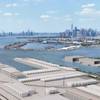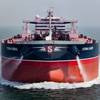Tampa Bay Shipbuilding & Repair Company was recently chosen by Maritrans Operating Partners L.P., a subsidiary of Maritrans, Inc., to retro-fit the company's second single-hull vessel, Ocean 244, to meet the requirements of OPA 90, through double-hull conversion.
Tampa Bay Shipbuilding & Repair Company will utilize the same Maritrans innovative CAD and manufacturing process (patent pending by Maritrans) used on Tampa's first conversion of Maritrans 192 (former Ocean 192).
"We've earned the importance of internal measurement [since the first conversion]," says Tom Hagner, double hull program manager for Maritrans. "As a result, we'lll be pre-fabricating modules in October, even though the barge won't be arriving until April; as compared to the first time, when we began pre-fabricating just two months before the vessel's arrival.
"Additionally, the yard has learned more about using its existing facilities to lift heavier pieces."
Based on an innovative design concept by the firm of Schuler and Allen, the construction was accomplished by Tampa Bay Shipbuilding in partnership with Maritrans' own technical staff. Even more impressive than the economic merits [the cost of the conversion was approximately $10 million, less than half the cost of a new barge similar to Maritrans 192], was the technical savvy required to complete the job.
"As far as we can tell, this was the first conversion from single hull to double hull anywhere in the world," says Hagner. "People have talked about fitting external double hulls, but we are more comfortable with Maritrans' internal retrofit concept. The cargo is completely protected by new steel, and we believe many metallurgical problems involving the containment structure are avoided."
Hagner adds, "The structure and coating of the original barge, which now makes up the converted barge's ballast tanks, was in superb condition. It is also useful that the major dimensions and hull hydrodynamic characteristics are unchanged so the vessel can continue to serve the same customers."
The Internal Refit Concept
The basic design concept is to use as much of the existing barge as possible to integrate smoothly with the entirely new internal double hull. The first step performed was a detailed inside measurement to detect changes from the design to "as-built." From these measurements, a significant amount of modular pre-assembly was completed long before the barge arrived in the yard.
When the barge first arrived, the deck was cut into five large pieces. Those pieces with their attached transverse and longitudinal bulkheads were removed and stored separately.
The prefabricated modules were laid on top of the existing bottom transverse frames and lapped onto the frames at the side. Forward and aft where the barge has more shape, the plating was installed in smaller increments. Because most of the original main deck and bulkheads were being raised to create a trunk deck, new lower portions of the transverse and longitudinal bulkheads were fabricated and fitted. While the work was going on inside, the new sidewalls of the raised trunk were being fitted to the original deck and bulkheads. Finally, the completed deck and upper bulkhead assembly was installed.
In all, approximately 1,400 tons of new steel was added to the unit.
The cargo volume of the barge was maintained by raising a trunk from the main deck almost 12 ft. using the existing structure to the maximum extent possible. The resulting double hull barge is very similar in concept to Maritrans' purpose-built double hull barges, Maritrans 300 and Ocean 400.
The structural design has been reviewed and approved by the American Bureau of Shipping. Finite element analysis was employed at each stage of the design. The most modern methods of parts programming and numberically-controlled steel cutting were used to prepare the individual plates prior to assembly.
"The fit-up of the modules went well," said Mike Keenan, president of Tampa Bay Shipbuilding. "In addition we carried out a producibility study in partnership with Maritrans that promises great saving for future projects."
All but inoperable in early 1997, the yard was able to assemble a management team and a work force to execute this complex project to the satisfaction of all concerned. Maritrans and Tampa Bay Shipbuilding established a strong working relationship from the first few weeks after the shipyard was selected following competitive bidding.
This was especially important since the design was owner-furnised and all aspects had to be tailored to the excellent handling facilities available at Tampa.
Advanced methodologies of partnering and association were applied throughout. Possibly the most important challenge was maximizing production efficiency during the mating of the sub-assemblies to the existing hull.
Stephen Van Dyck, chairman and CEO of Maritrans, Inc., credits the management of Tampa Bay with "having worked hard with Maritrans to create the foundation for a partnership that will make the expected future rebuild projects even more successful. After an appropriate trial period on M-192, and assuming no big surprises in the industry, we will have another 10 barges to rebuild."
OPA 90 requires all existing single-hull vessels engaged in the maritime transport of oil and petroleum products be retro-fitted with double hulls or be retired by 2015. Maritrans Ocean 192 was the pilot retro-fit setting the standard for all future reconstruction of Maritrans' superbarges.
The OPA 90 retirement dates for Maritrans' super barges extend from 2003 to 2010. Maritrans intends to do roughly one conversion a year beginning around the turn of the century.
Lawsuit Progressing
In August, 1996, Maritrans filed a lawsuit against the federal government, claiming 37 of its tank barges were "taken" without just compensation, in violation of the Fifth Amendment of the U.S. Constitution, as a result of the double hull mandate of OPA 90. Essentially, the question is whether the company could have anticipated a double hull mandate when it purchased the single hull barges. If such a mandate could not have been reasonably anticipated, a "taking" has occurred.
In March, 1999, the U.S. Court of Federal Claims dismissed the company's cause of action, since it seemed Maritrans had not yet been affected by this mandate. Since the lawsuit was requesting compensation, it would impossible to gauge amounts, if not costs had been incurred. However, once the $10 million investment in Maritrans 192 was referenced, the decision was reversed, and both parties are now preparing for the second phase of the trial.
Vessel Specifications
Designers: Schuler & Allen
Classification: ABS
Length, o.a.: 480 ft.
Breadth: 84 ft.
Depth to main deck: 35 ft.
Draft: 30 ft.
Capacity: approx. 180,000 barrels
Number of cargo tanks: 12
Number of segregations: 4
Lofters/ NC Programmers: DNC
Ballast system: Ameron
Piping installation: Global
Paint: Devoe
Blasting and coating: IMIA
April 2025
 Read the Magazine
Read the Magazine

 Read the Magazine
Read the Magazine
This issue sponsored by:

Massa Products Corporation: Innovating Sonar Technology & Securing the Future of the Maritime Workforce
Subscribe for
Maritime Reporter E-News
Maritime Reporter E-News is the maritime industry's largest circulation and most authoritative ENews Service, delivered to your Email five times per week












